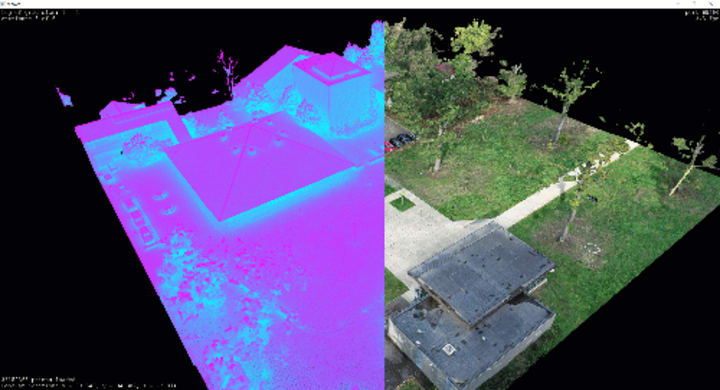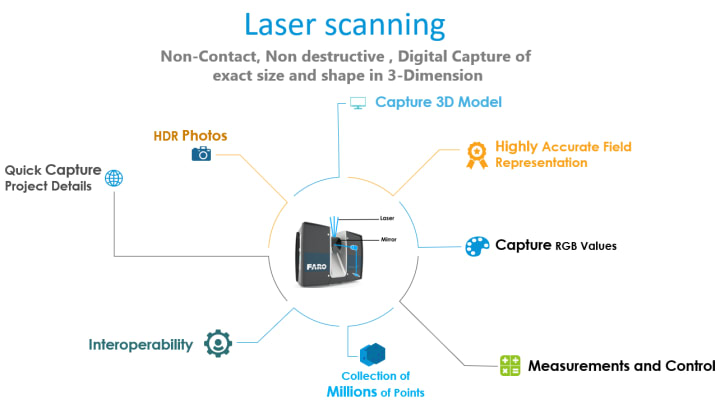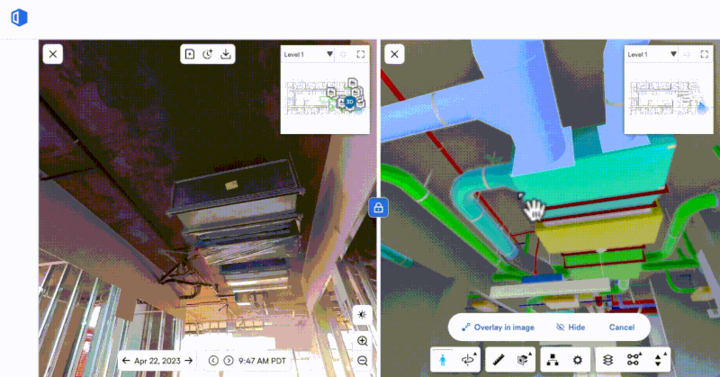How 3D Laser Scanning Improves Construction Efficiency?
Boosting Speed, Accuracy, and Collaboration

The construction industry has traditionally relied on tape measures, hand-drawn sketches, and time-consuming surveying techniques. However, with the advent of 3D laser scanning technology, a new era of efficiency and precision has arrived.
This article explores how 3D laser scanning transforms construction projects by streamlining workflows, minimizing errors, and fostering better collaboration.
Also you would like explore the complete guide on 3d laser scanning.
What is 3D Laser Scanning?

3D laser scanning, also known as LiDAR (Light Detection and Ranging), utilizes a pulsating laser beam to capture millions of data points from a physical environment. These data points are then processed to create a highly accurate 3D representation of the scanned area, known as a point cloud. This point cloud can be manipulated and analyzed using specialized software, providing a wealth of information for construction professionals.
Benefits of 3D Laser Scanning for Construction Efficiency

3D laser scanning offers a multitude of advantages over traditional methods, leading to significant improvements in construction efficiency.
Here's a detailed breakdown of these benefits:
Enhanced Accuracy and Speed:
Compared to manual surveying, which can be slow and prone to human error, 3D laser scanners can capture vast amounts of data (millions of data points) in a matter of minutes. This translates to faster project kickoffs and a minimized risk of errors due to inaccurate measurements.
Detailed Site Capture:
Unlike traditional methods that focus on specific points, 3D scanning captures the entire existing site conditions, including topography, utilities, and potential obstacles. This comprehensive data allows for better planning and informed decision-making throughout the construction process.
Improved Clash Detection:

One of the most significant benefits of 3D laser scanning is its ability to identify potential clashes between different building elements before construction begins. By overlaying the 3D models of various building systems (electrical, plumbing, HVAC) within the scanned point cloud, engineers can proactively identify and address any conflicts, such as overlapping ductwork or colliding pipes. This eliminates costly rework later in the project.
Also Read: How BIM Clash Detection Reduce Construction Rework & Costs?
Prefabrication and Modular Construction:
The precise dimensional data obtained from 3D scans facilitates the use of prefabrication techniques. Building components can be manufactured off-site in a controlled environment, ensuring higher quality and reducing on-site labor costs.
Additionally, 3D scanning enables modular construction, where prefabricated building units are assembled on-site, leading to faster project completion times.
Enhanced Layout and Fabrication:
Highly accurate layout plans for foundations, walls, and other building elements can be generated from laser scans. This minimizes errors during construction and reduces the need for rework due to misaligned components. Construction crews can confidently rely on the data from the scan to ensure precise placement of building elements.
Improved Communication and Collaboration:
3D models generated from laser scans provide a shared visual reference for all stakeholders involved in the project, including architects, engineers, and subcontractors.
This facilitates better communication and collaboration by ensuring everyone is working from the same set of data. Potential issues can be identified and addressed collaboratively, leading to a smoother and more efficient construction process.
Facility Management and Maintenance:
3D scan data can be used for facility management and maintenance purposes even after construction is complete. The detailed point cloud serves as a digital twin of the building, allowing for efficient space planning, asset tracking, and maintenance scheduling.
Applications of 3D Laser Scanning in Construction
3D laser scanning finds application in various stages of the construction lifecycle, offering significant benefits at each step:
Pre-Construction Planning:
3D scans are used to create accurate site plans, identify potential challenges, and plan for logistics and material deliveries.
Design and Engineering:
Scan data can be integrated with Building Information Modeling (BIM) software to create a comprehensive digital model of the building. This facilitates clash detection, design optimization, and better coordination between different disciplines.
Construction Phase:
On-site layout and verification, prefabrication of building components, quality control inspections, and progress tracking can all be enhanced with the help of 3D scan data.
Facility Management:
As-built documentation can be generated from scans, providing a valuable resource for future maintenance and renovation projects.
Challenges and Considerations for Implementing 3D Laser Scanning
While 3D laser scanning offers immense benefits, there are also some challenges to consider:
Cost: The initial investment in 3D scanning equipment and software can be significant. However, the long-term cost savings due to improved efficiency and reduced rework often outweigh the initial investment.
Expertise: Utilizing 3D scan data effectively requires skilled personnel who can operate the scanners, process the data, and integrate it with other project management tools.
Data Management: The vast amount of data generated by 3D scans needs to be properly managed and stored. Implementing a robust data management strategy is crucial to ensure easy access and retrieval of scan data throughout the project lifecycle.
Overall, the benefits of 3D laser scanning far outweigh the challenges. As the technology becomes more affordable and user-friendly, its adoption in the construction industry is expected to continue to grow.
The Future of 3D Laser Scanning in Construction
The future of 3D laser scanning in construction is bright. Here are some exciting trends to look forward to:
Integration with Advanced Technologies: We can expect to see increased integration of 3D scanning with other advanced technologies like drones, robotics, and virtual reality (VR). This will allow for even faster and more comprehensive data capture, as well as immersive visualization of construction projects.
Real-Time Monitoring: Advancements in sensor technology will pave the way for real-time monitoring of construction progress using 3D scans. This will enable proactive identification and resolution of issues, further enhancing construction efficiency.
Automated Quality Control: 3D scanning data can be leveraged for automated quality control processes. By comparing scanned data with BIM models, deviations from the design can be automatically identified, leading to faster and more accurate quality checks.
In conclusion, 3D laser scanning is revolutionizing the construction industry by promoting efficiency, minimizing errors, and fostering better collaboration. As the technology continues to evolve and become more accessible, we can expect to see even more innovative applications emerge, shaping the future of construction into a more streamlined, data-driven, and efficient process.
Further Reading
About the Creator
Matt Sharon
A professional content writer. Having years of experience in Technology, health, finance, and construction and real estate field. Writing is my passion and I love to play with words Confidently.
Enjoyed the story? Support the Creator.
Subscribe for free to receive all their stories in your feed. You could also pledge your support or give them a one-off tip, letting them know you appreciate their work.






Comments
There are no comments for this story
Be the first to respond and start the conversation.